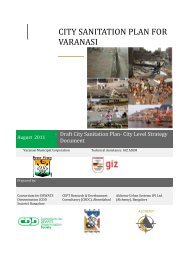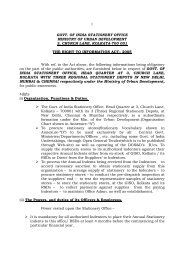CITY SANITATION PLAN - Ministry of Urban Development
CITY SANITATION PLAN - Ministry of Urban Development
CITY SANITATION PLAN - Ministry of Urban Development
You also want an ePaper? Increase the reach of your titles
YUMPU automatically turns print PDFs into web optimized ePapers that Google loves.
<strong>CITY</strong> <strong>SANITATION</strong> <strong>PLAN</strong> BAREILLY<br />
tanks, to sewer and to nalas. The sludge that is collected into septic tanks is disposed-<strong>of</strong>f improperly.<br />
And the present conditions <strong>of</strong> the septic tanks are also bad. From the analysis, about 30% <strong>of</strong> the<br />
community toilets with septic tanks are in broken status or over flowing. This is creating the<br />
surrounding areas very unhygienic and with stinking smell – that creates hurdle to most <strong>of</strong> the usage<br />
<strong>of</strong> community toilets. In about 80% <strong>of</strong> the community toilets with septic tanks, the fecal sludge<br />
collected from these septic tanks by the municipalities or private sludge sucking machine and they<br />
dispose it into nearby nalas. This shows that there need to some serious or potential problems in<br />
sludge management systems with community toilets. In addition to the disposal <strong>of</strong> sludge produced<br />
at community toilets there are also about 10% <strong>of</strong> the community toilets using the sludge to soak pits.<br />
There are about 15% <strong>of</strong> the community toilets whose sludge is directly let into open nalas.<br />
In addition to the above mentioned sludge management, there is also effluent waste that is<br />
generated from the community toilets – which also require proper disposal mechanisms. The<br />
analysis shows that there is about 98% <strong>of</strong> the community toilets have no proper effluent waste<br />
management. There are all let into open drains. There is only about 2% <strong>of</strong> the number <strong>of</strong> community<br />
toilets effluent waste disposed/ connected to sewer lines. The following graph shows the percentage<br />
share <strong>of</strong> community toilets according to their discharge mechanism <strong>of</strong> effluent waste.<br />
In addition to the above mentioned analysis, it is also important to consider who all are responsible<br />
for O&M arrangements <strong>of</strong> these community toilets. There are different government bodies, private<br />
agencies and NGOs those are responsible for O&M arrangements <strong>of</strong> these community toilets. The<br />
different organizations those are responsible are Nagar Nigam, DUDA, Jal Nigam, NEDA, Nagla Teja<br />
ADMINISTRATIVE STAFF COLLEGE OF INDIA, HYDERABAD Page 81
















